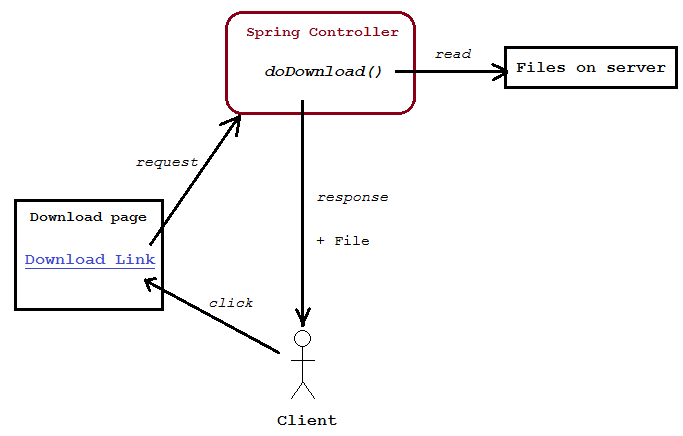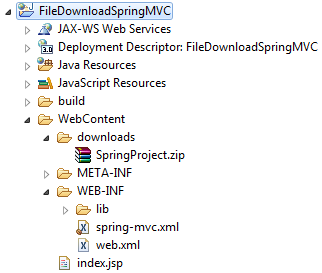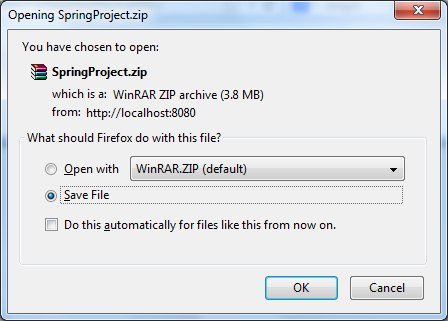Spring MVC sample application for downloading files
http://www.codejava.net/frameworks/spring/spring-mvc-sample-application-for-downloading-files
n this article, we are going to show you how to implement file download functionality in a Spring MVC application. The solution is similar to the one described in the article: Send files from servlet to client for downloading, but is implemented in a Spring MVC application.
The following picture depicts workflow of the sample application we are going to build:

Project structure (Eclipse project):

The file to be downloaded in this application is SpringProject.zip file which resides in the downloads directory which is relative to the application’s directory.
1. Code of download page
Create index.jsp file under WebContent directory with the following HTML code:
|
1
2
3
4
5
6
7
8
9
10
11
12
13
14
15
|
<%@ page language="java" contentType="text/html; charset=ISO-8859-1" pageEncoding="ISO-8859-1"%><!DOCTYPE html PUBLIC "-//W3C//DTD HTML 4.01 Transitional//EN" "http://www.w3.org/TR/html4/loose.dtd"><html><head><meta http-equiv="Content-Type" content="text/html; charset=ISO-8859-1"><title>Download Page</title></head><body> <center> <h2><a href="/download.do">Click here to download file</a></h2> </center></body></html> |
This page simply shows a link “Click here to download file” with URL points to the relative path: download.do. We’ll configure Spring controller class to handle this URL.
2. Code of Spring controller class
Create FileDownloadController.java file under the source package net.codejava.spring with the following code:
|
1
2
3
4
5
6
7
8
9
10
11
12
13
14
15
16
17
18
19
20
21
22
23
24
25
26
27
28
29
30
31
32
33
34
35
36
37
38
39
40
41
42
43
44
45
46
47
48
49
50
51
52
53
54
55
56
57
58
59
60
61
62
63
64
65
66
67
68
69
70
71
72
73
74
75
76
77
78
79
80
|
package net.codejava.spring;import java.io.File;import java.io.FileInputStream;import java.io.IOException;import java.io.OutputStream;import javax.servlet.ServletContext;import javax.servlet.http.HttpServletRequest;import javax.servlet.http.HttpServletResponse;import org.springframework.stereotype.Controller;import org.springframework.web.bind.annotation.RequestMapping;import org.springframework.web.bind.annotation.RequestMethod;@Controller@RequestMapping("/download.do")public class FileDownloadController { /** * Size of a byte buffer to read/write file */ private static final int BUFFER_SIZE = 4096; /** * Path of the file to be downloaded, relative to application‘s directory */ private String filePath = "/downloads/SpringProject.zip"; /** * Method for handling file download request from client */ @RequestMapping(method = RequestMethod.GET) public void doDownload(HttpServletRequest request, HttpServletResponse response) throws IOException { // get absolute path of the application ServletContext context = request.getServletContext(); String appPath = context.getRealPath(""); System.out.println("appPath = " + appPath); // construct the complete absolute path of the file String fullPath = appPath + filePath; File downloadFile = new File(fullPath); FileInputStream inputStream = new FileInputStream(downloadFile); // get MIME type of the file String mimeType = context.getMimeType(fullPath); if (mimeType == null) { // set to binary type if MIME mapping not found mimeType = "application/octet-stream"; } System.out.println("MIME type: " + mimeType); // set content attributes for the response response.setContentType(mimeType); response.setContentLength((int) downloadFile.length()); // set headers for the response String headerKey = "Content-Disposition"; String headerValue = String.format("attachment; filename=\"%s\"", downloadFile.getName()); response.setHeader(headerKey, headerValue); // get output stream of the response OutputStream outStream = response.getOutputStream(); byte[] buffer = new byte[BUFFER_SIZE]; int bytesRead = -1; // write bytes read from the input stream into the output stream while ((bytesRead = inputStream.read(buffer)) != -1) { outStream.write(buffer, 0, bytesRead); } inputStream.close(); outStream.close(); }} |
This is a typical Spring controller class which is annotated by Spring MVC annotation types. The method doDownload() will receive requests from the client, read the file on server and send it to the client for downloading. Note that, unlike traditional Spring controller’s methods, the method doDownload()does not return a view name, because our purpose is to send a file to the client. The method exits as soon as the file is completely transferred to the client.
Recommended Book: Getting started with Spring Framework
3. Code of Spring configuration file
Create spring-mvc.xml file under WebContent\WEB-INF directory with the following content:
|
1
2
3
4
5
6
7
8
9
10
11
12
13
|
<?xml version="1.0" encoding="UTF-8"?><beans xmlns="http://www.springframework.org/schema/beans" xmlns:xsi="http://www.w3.org/2001/XMLSchema-instance" xmlns:context="http://www.springframework.org/schema/context" xsi:schemaLocation="http://www.springframework.org/schema/beans http://www.springframework.org/schema/beans/spring-beans-3.0.xsd http://www.springframework.org/schema/context http://www.springframework.org/schema/context/spring-context-3.0.xsd"> <context:component-scan base-package="net.codejava.spring" /> <!-- your beans declaration goes here --></beans> |
This is a deadly simple Spring configuration file which tells the framework to scan the package net.codejava.spring for annotated types (element <context:component-scan />). Of course your application will have some bean definitions, but for the purpose of this application, such configuration is enough to work.
Related Course: The Java Spring Tutorial
4. Code of web.xml
The Spring dispatcher servlet is configured to handle requests in the web.xml file as follows:
|
1
2
3
4
5
6
7
8
9
10
11
12
13
14
15
16
17
18
19
20
21
22
23
|
<?xml version="1.0" encoding="UTF-8"?><web-app xmlns:xsi="http://www.w3.org/2001/XMLSchema-instance" xmlns="http://java.sun.com/xml/ns/javaee" xmlns:web="http://java.sun.com/xml/ns/javaee/web-app_2_5.xsd" xsi:schemaLocation="http://java.sun.com/xml/ns/javaee http://java.sun.com/xml/ns/javaee/web-app_3_0.xsd" id="WebApp_ID" version="3.0"> <display-name>FileDownloadSpringMVC</display-name> <servlet> <servlet-name>SpringController</servlet-name> <servlet-class>org.springframework.web.servlet.DispatcherServlet</servlet-class> <init-param> <param-name>contextConfigLocation</param-name> <param-value>/WEB-INF/spring-mvc.xml</param-value> </init-param> <load-on-startup>1</load-on-startup> </servlet> <servlet-mapping> <servlet-name>SpringController</servlet-name> <url-pattern>*.do</url-pattern> </servlet-mapping></web-app> |
Recommended Book: Spring in Action
5. Required jar files
Add the following jar files into the WebContent\WEB-INF\lib directory:
- commons-logging-1.1.1.jar
- spring-beans-3.2.1.RELEASE.jar
- spring-context-3.2.1.RELEASE.jar
- spring-core-3.2.1.RELEASE.jar
- spring-expression-3.2.1.RELEASE.jar
- spring-web-3.2.1.RELEASE.jar
- spring-webmvc-3.2.1.RELEASE.jar
The Commons Logging jar files can be downloaded from Apache Commons Logging, other jar files come from Spring framework 3.2.1 RELEASE download.
Related Course: The Java Spring Tutorial
6. Testing the application
Deploy the application on localhost Tomcat server, type the following URL into browser’s address bar:
http://localhost:8080/FileDownloadSpringMVC/
The download page is displayed:

Click on the link, the browser will ask to download the file:

You can download Eclipse project for this application as well as deployable WAR file in the attachment section below.
NOTES: One may ask why not just putting a file somewhere on the server and give the users a link to download it? Of course that will work, however that is a static way. By handling the file to be downloaded programmatically, we can obtain the following benefits:
-
- Delivering the files dynamically, based on user’s requests.
- Controlling access to the files: who can download and when the download is available.
- Hiding the actual location of files on the server.
Recommended Book: Spring in Practice
[转] Spring MVC sample application for downloading files,,5-wow.com
郑重声明:本站内容如果来自互联网及其他传播媒体,其版权均属原媒体及文章作者所有。转载目的在于传递更多信息及用于网络分享,并不代表本站赞同其观点和对其真实性负责,也不构成任何其他建议。


































